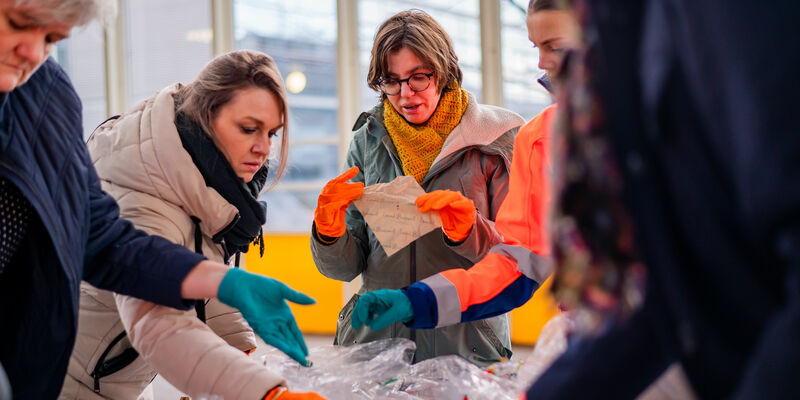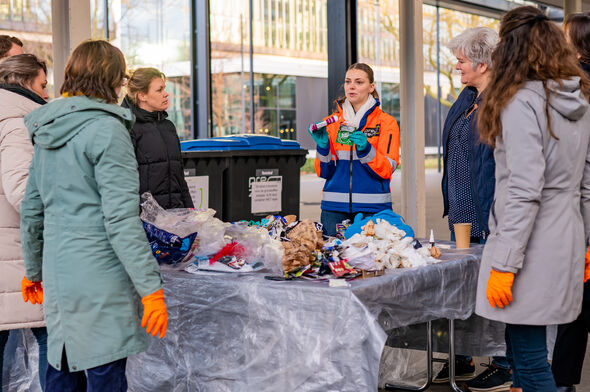
- Campus , The University
- 15/12/2023
Sifting through garbage to improve waste separation
From a broken Christmas bauble to a fleece jacket, Cursor saw it all during Tuesday morning's dive into the Atlas garbage bins, helping with a waste analysis. In recent weeks, PreZero, TU/e's new waste processor has been carrying out a comprehensive analysis, examining the non-recyclable waste deposited at eighteen campus locations. What is going well, and what can be done better?
With practiced ease, Céline Knubben, Zero Waste project leader with waste processor PreZero, holds a large garbage bag upside down to empty it. Standing around the table are various TU/e employees – all of them involved in sustainability, either personally or professionally – wearing heavy-duty orange gloves. We wait for Knubben's start sign, then everyone reaches for the mountain, and the rapid categorizing of waste begins. “The other day we found a half-full carton of Chinese takeaway. Not what you wanna see so early in the morning,” one of the team recalls, wrinkling his nose.
We are standing in the Market Hall in MetaForum, where the contents of a wheelie bin are being analyzed this morning. It's a bin for non-recyclable waste and it stands in Atlas, the last of the eighteen TU/e locations selected. Repeatedly in recent weeks, you could have found Knubben in the Market Hall, standing over a waste mountain and often accompanied by the management staffer for the relevant location. That the crowd gathered at the sorting table today is a little bigger than usual is something Knubben can only applaud. “Reducing the waste stream is something you have to do together. These baseline measurements are the first step towards that goal. We want to know exactly what the non-recyclable waste includes. Are there, for instance, differences to be seen between the locations? In a lab different things are thrown away than in a canteen. Once we've carried out a thorough analysis, we can create a step-by-step plan for separating waste even better than we currently do, or perhaps for adding a new waste stream.”
Where does this potato chip bag go?
After a flying start, the waste at the table is being steadily sorted. One corner has been reserved for garden, fruit & veg waste. As well as many teabags, half a stick of bread and a heap of paprika-flavor potato chips are lying here. We have a pile of plastic waste, a heap of tissues – a bumper crop thanks to this being the flu season – and a corner for paper. Strangely enough, the amount of non-recyclable waste isn't at all excessive.
And just like at home, when you stand there, item in hand, feeling puzzled, so here too there are moments when the correct sort isn't completely clear. Tiny Poppe, part of the TU/e campaign Let's Go Zero team, together with Bregje Portier and Martine de Graaff, is waving an empty potato chip bag around. “Does this go with PMD - the recyclable plastics, metals and cartons - or non-recyclables?” Knubben guides us through every sorting quandary and explains that there's no easy answer for the potato chip bag. “It's made of what's called a laminate material, in this case aluminum and plastic, which we can't recycle. It's okay to put it in with the PMD waste because it can be separated out. But since that route means adding an extra logistical step to get it to the waste incinerator, I prefer to put it in with the non-recyclables.”
Waste-free university
To reduce the waste stream at TU/e and increase sustainability on the campus, the campaign Let’s Go Zero was started in 2021. Now, students and employees can leave their sorted trash in special Tulip garbage bins, to be found in every building; disposable coffee cups can no longer be found on campus; and more and more catering outlets at TU/e are running the food waste app Too Good To Go. But we want to become even greener, stresses Bregje Portier. “Our aim is to be a waste-free university in 2030. That means no more non-recyclable waste. And that's why we want to see waste prevented wherever possible, otherwise reused and recycled. Reduce, reuse, recycle! Our new waste processor PreZero is going to help us, and that's why we're here at this table together.”
There are a number of important aspects to becoming waste free as a university, says Knubben, each of which will be examined in turn in the coming months. “Circular purchasing plays a big role; which materials are entering at the front end? We want to use data to gain greater insight into the whole chain, ultimately linking all the various inputs. Then, suppose a department were to throw out a certain material, another department could use it. For the rest, we're looking at the back-end waste streams and investigating where recycling can be improved.”
“In previous waste analyses we came across a great many boxes containing polystyrene and cooling elements at the laboratories,” continues Knubben. “Now, with TU/e we're looking at ways to dispose of these items more sustainably and whether alternatives are available. Our campus users are very important because, at the end of the day, they are the people who have to reduce the waste mountain. Of course, the first step is having a green policy, but paying the subject more attention within the departments and during lectures all helps raise awareness. Before people start taking action, they first have to understand.”
Warm fleece jacket
Then suddenly there's a buzz in the group. A blue fleece jacket, a quality brand, appears from under the garbage. The zipper is tested; it's still working well. Monique Kuyck, head Operational Services & Locatiemanagement of the Facility Management Center, shakes her head. “This is a circularity disaster, things have really got to change. As long as good products keep ending up in the trash, and we keep on buying stuff, nothing will change.” The Facility Management Center implements the university's policy and helps its users to take sustainable steps, Kuyck explains. “As well as a waste-free campus, we also want to have a fully circular campus in 2050. Minimal use of raw materials, and optimum use of them. Always ask yourself first: is this really necessary? If it is, look first within your own organization, then if you have to purchase, choose second-life or recycled goods. And look for alternatives. You'll appreciate that the sight of all these balloons on campus lately makes me feel far from festive.”
Greasy paper
In the meantime, the Atlas waste has been thoroughly sorted. What strikes Knubben about it all? “Half of what's lying on the table shouldn't be here. We're seeing a lot of food waste, and a lot of plastic packaging. Why? Properly sorted, it can go into the Tulips and be recycled. For the rest, the paper wrappings from the teabags can simply go into the paper bin, but dry, please. The place for everything that has been in contact with food or carries traces of moisture or grease is the non-recyclables. What we're seeing here is something we see in almost all our analyses. Things are going slowly in the right direction, but there are still plenty of steps ahead of us. We're only going to cut the mountain down to size if we work together.” Before we leave, Poppe puts words into action and pulls out the fleece jacket – once it has had a good wash, she will give it to the Salvation Army.

Discussion